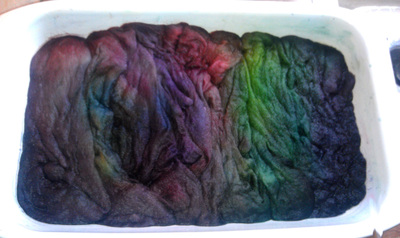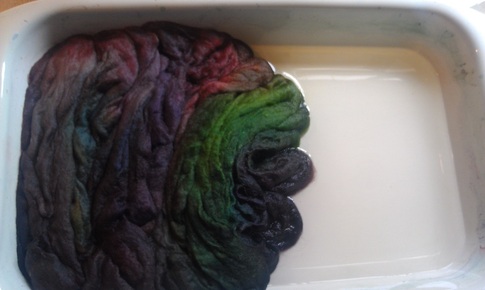I have a secret about dying that I'd like to share with everyone. Traditional fiber, like wool and alpaca, requires a pretty elaborate dying method that many people find incredibly time consuming. I consider my own personal method to be much easier and less hassle, even more so when you consider how I dye firestar. Now before I get into that, let me give you a brief overview for how I dye everything else:
Dyes I use: Greener Shades, Jacquard, and Dharma Acid Dye. I also use some all natural dyes that are hand made, but for the sake of this post I'll leave it to the professional dyes.
To dye roving:
I saturate the fiber in hot water, then lay out a large clear lasagna pan. This is about the closest thing to cooking that i ever do. After the initial pre-soak (only really necessary for tough fibers like merino, which are slightly hydrophobic and require more battling to get submerged), I add just a hint of citric acid to the pan full of hot water, then lay the roving out in whatever way I want.
I take my dedicated dye tool (it used to be a spatula, I've since upgraded to a flat piece of plastic that works wonders) and dip it in the jars of powdered dye, taking out just a little bit of dye at a time. I sprinkle the dye in whatever place I want it to be (or just mix it in if I'm being "free") and let the colors blend themselves in the pan. It's pretty easy to get a feel for how much dye is enough and how much dye is too much -- there's a saturation point where the color simply won't take anymore and you don't want to waste your dye. Usually that's not an issue for me since I rarely go with super dark colors.If you are just starting out, just look at the color that you are creating. When it looks how you want it to be, stop adding dye. It's that simple.
That's it. I make sure all of the wool has color (you can lift it to get the under-side), pop it in the oven for about 30 minutes on 225 F, and when I take it out the water is clear --- that's how you know it worked. If your water is still colored, then you either didn't put enough citric acid in (vinegar also works) or you put too much dye in. A little bit of color left is ok, a lot of color left is a problem.
I love this way of dying fiber because not only is it incredibly easy, but it's also highly effective and allows me to really "paint" on the colors wherever I want. As a life-long artist, this is very similar to watercolor painting, so I find myself enjoying it a lot.
Here's some photos to show the simple dying process of roving: 

Pulling the roving back to make sure all of the color is out of the water.


The finished roving.
Something important about dying roving is that you need to lift up the roving to make sure the color has a chance to get under it and fully saturate it. Wool, alpaca, and most other animal fibers are naturally going to want to repel the water, so it sometimes takes a little convincing. Pre-soaking the wool in warm water helps with this a lot, as well as lifting the fleece to get the under-side. You can gently squeeze the wool while it's under the tap and it shouldn't felt if you are careful.
For firestar: the "Dip & Rinse" method by Holly Madison:
Here's where the fun trick comes in!
If you don't know what Firestar is:
Firestar is often used to add sparkle and just a touch of glitz to fiber batts, rolags, and felting. A little goes a long way, and it's amazing how beautiful a little sparkle can be (unlike angelina fiber which is 1) scratchy 2) can't be dyed and 3) is a bit TOO in your face for some people's taste), firestar is simple and lovely (I still like angelina, it just has to be the right kind of project).
Firestar has an awesome advantage over roving though! Instead of needing to go through the acid process, and either microwaving or baking it, you can do what I do and get wonderful results.
I start by keeping my firestar dry and making small bowls of the colors I want to use. You can still do the sprinkle method, but since the dye sets so fast, it's better to be prepared.
No acid or heat is required to set the color in firestar as long as you're using Acid Dyes.
Just dip the fiber in the color that you want, and move on to the next color. If you don't want the colors to blend, you can rinse in between dips. You can also blend colors -- for example, I was making a batch of bright rainbow firestar for a custom order along with a pastel rainbow batch. For the pastel rainbow, I dipped the firestar in the red for just a second, then dipped part of the red and some undyed firestar into the yellow bowl, creating an orange color where they mixed. A few seconds in each color is all it takes for permanent, beautiful colors.If you want darker colors, you can add a tiny bit of vinegar or citric acid and it will speed up the dying process, making it only take 1 dip for a dark or bright color instead of several dips.
I discovered this trick in a happy accident when I dyed some firestar the wrong color a long time ago, and tried to wash it out. It didn't work... in fact, nothing I did got the color out! I realized at that moment that this could be a fantastic advantage since it makes dying take literally seconds instead of a half an hour!
If you want darker colors, you can add just a pinch of citric acid or vinegar to the dye bath. I sometimes do multiple dips as well to get super vibrant colors, but it only takes a few seconds in each color.
If you are using only a tiny bit of dye, your water will run clear after a second or two, and that's when you know the dye has set in. The other way of testing is to run your firestar under the tap and let the water get clear. You will be able to see how well the dye has taken at that point, and whether or not you think you will need a second dip in the dye bath.
And that's it! Let me know if you have any questions.


Wow! Thanks so much for the tip on firestar!
ReplyDeleteBrandy
Just what I was looking for !
ReplyDeleteDoes koolaide work with this?
ReplyDelete